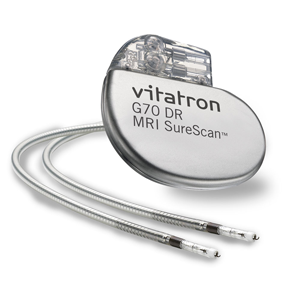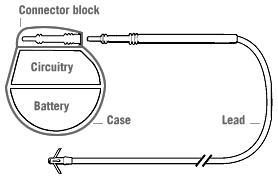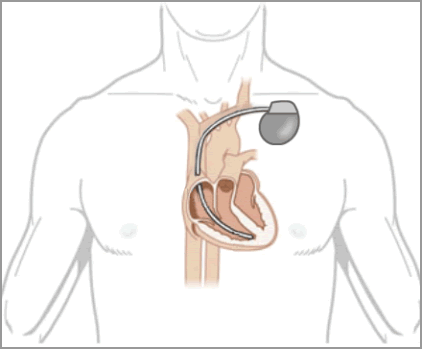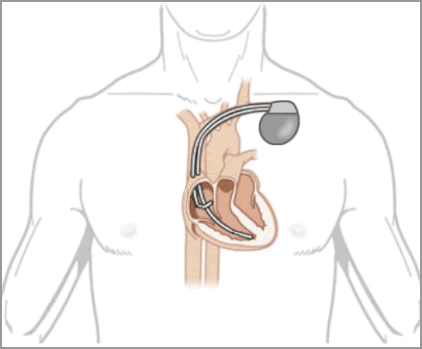Your Pacemaker
This page contains some basic information about pacemakers. Although we can supply general information about various topics, we are not familiar with personal conditions and clinical circumstances. As a (future) pacemaker wearer, your cardiologist/physician should be your first contact. He or she can provide in-depth information about a specific situation or condition.
What is it?
What is a pacemaker? A pacemaker is an implanted medical device that stimulates the heart muscle with precisely timed discharges of electricity, which cause the heart to beat in a manner very similar to the natural heart rhythm. Pacemakers are prescribed for people whose hearts beat too slowly or irregularly.
A pacemaker consists of the following components:
Battery:
the pacemaker battery is the power supply. It is a small, sealed, lithium battery, that will generally last for many years (the average battery lifetime is 8 years). The energy from the battery is delivered as tiny electrical impulses that stimulate the heart.
Circuitry:
the circuitry is a kind of miniature computer inside the pacemaker. It controls the timing and intensity of the electrical impulses delivered to the heart.
Case:
the battery and circuitry are sealed inside a metal case.
Connector block:
the plastic (epoxy) connector, which lies on top of the pacemaker's metal case, provides the connection between the pacemaker and the lead(s).
The lead
The pacing lead is an insulated wire that carries the electrical impulse to the heart, and carries information about the heart’s natural activity back to the pacemaker. One end of the lead is connected to the connector block. The other end is usually inserted through a vein and placed in the right ventricle or the right atrium. Either one or two leads are used depending on the type of pacemaker. At a heart rate of 70 beats per minute, the lead will bend about 100,000 times a day! Therefore, leads are extremely flexible and strong, so that they can withstand the twisting and bending caused by movement of the body and of the beating heart.
How does a pacemaker work?
A pacemaker has two essential tasks: pacing and sensing.
Pacing means that the pacemaker paces the heart in case the heart’s own rhythm is interrupted, irregular, or too slow.
Sensing means that the pacemaker monitors the heart’s natural electrical activity. If a pacemaker senses a natural heartbeat it will not stimulate the heart.
What types of pacing are there?
Depending on your heart condition, your doctor will prescribe which chambers
should be paced. Pacemakers are designed for either (rate responsive)
single chamber or (rate responsive) dual chamber pacing.
In single chamber pacing, either the right atrium or the right ventricle is paced. Only one lead is used. The pacemaker senses (monitors) electrical activity in either the atrium or the ventricle and determines whether or not pacing is needed.
In dual chamber pacing, the pacemaker senses (monitors) electrical activity in both the atrium and the ventricle and determines whether or not pacing is needed. Dual chamber pacemakers help the upper and lower chambers of your heart to beat in their natural sequence. This way, a paced heartbeat mimics a natural heartbeat.
Rate responsive pacing
Rate responsive pacemakers can be single chamber or dual chamber pacemakers.
Rate responsive pacing is needed when your heart cannot adjust its rate
to meet the body’s demands. Your normal heart rhythm slows down
or speeds up many times during the day depending on the level of activity
and other factors. It slows down while you are resting or sleeping and
it speeds up in response to exercise and excitement. A rate responsive
pacemaker uses (a) special sensor(s) that can recognize body changes.



Components of a pacemaker

Single chamber pacing

Dual chamber pacing

